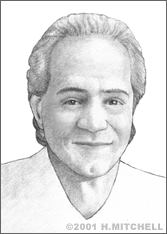Raymond Kurzweil
Raymond Kurzweil is one of the world’s true pioneers in the field of human-computer interfacing. Born in Queens, New York in 1948, Kurzweil grew up in an academic family. His grandmother was one of the first women in Europe to earn a PhD in chemistry. His parents were artists—his father was a musician and conductor and his mother was a visual artist—who encouraged young Kurzweil’s creativity. At the age of five, he began building his own model boats, cars, and rocket ships. He built a simple computing device when he was 12, and he also learned how to program with the help of his uncle, an engineer at Bell Labs.
When Kurzweil was 15, he began his first project involving pattern recognition, or teaching machines how to see and understand patterns in information. In high school, Kurzweil began corresponding with Marvin Minsky, an artificial intelligence guru at the Massachusetts Institute of Technology (MIT). Kurzweil chose to attend MIT partially because of his relationship with Minsky. There, he double-majored in computer science and creative writing.
While he was taking classes, Kurzweil founded a company where he used a computer to match high school students with colleges. He later sold his company to Harcourt for $100,000 plus royalties. In 1970, he completed his BS at MIT and just a few years later, he founded Kurzweil Computer Products, a software and hardware company. There, Kurzweil and his team invented what would be one of the hallmarks of his entire career—the Kurzweil Reading Machine, which included the first CCD ("charge coupled device") flatbed scanner and first omni-font OCR ("optical character recognition") software. The machine used only 64K of RAM and was able to scan lines of text one at a time. The machine "recognized" each character as it passed, regardless of typestyle; corrected the order of the characters in its memory; determined the pronunciation of the resultant words according to pre-programmed phonological rules; and articulated those words through a speech synthesizer, also created by the company.
The Kurzweil Reading Machine was introduced in 1976. It has been called the first commercial product to use artificial intelligence technology successfully. The machine also provided a foundation for all subsequent text-speech technology, including the automatic speech recognition systems developed by Kurzweil and his colleagues at Kurzweil Applied Intelligence in the late 1980s.
Later models of Kurzweil’s speech recognition system allow all typing, editing, and formatting of a text file to be done by voice alone. The system can also gradually improve its grasp of a given user's speech habits as it works, making fewer mistakes over time.
Significantly, Kurzweil’s reading machine concept gave blind people access to printed material. One of the first users of the system was the musician Stevie Wonder. In fact, in the early 1980s, it was Wonder who suggested to Kurzweil the possibility of bridging the gap between acoustic and electronic musical instruments.
Soon after, Kurzweil formed Kurzweil Music Systems with Wonder as the musical advisor. Kurzweil and his team set out to invent a method of capturing and recreating the true sounds and musical responses of acoustic musical instruments, such as the grand piano, violin, guitar, and drums. In 1983, the team created the K250 keyboard synthesizer, the first electronic instrument to successfully reproduce the sounds of acoustic instruments. Kurzweil sold Kurzweil Music Systems to Young Chang, a large Korean musical instrument company, in 1990.
Kurzweil has won a number of awards for his work, including the 2001 $500,000 Lemelson-MIT Prize, as well as the 1999 National Medal of Technology from President Clinton and Design News’ Engineer of the Year award in 1990. He has been awarded 11 honorary doctorate degrees and has received awards from 3 U.S. Presidents. He also wrote the award-winning book, "The Age of Intelligent Machines" in 1990, which was accompanied by an award-winning documentary film, and “The Age of Spiritual Machines” in 1999, which was the highest rated product in the category of science on Amazon.


